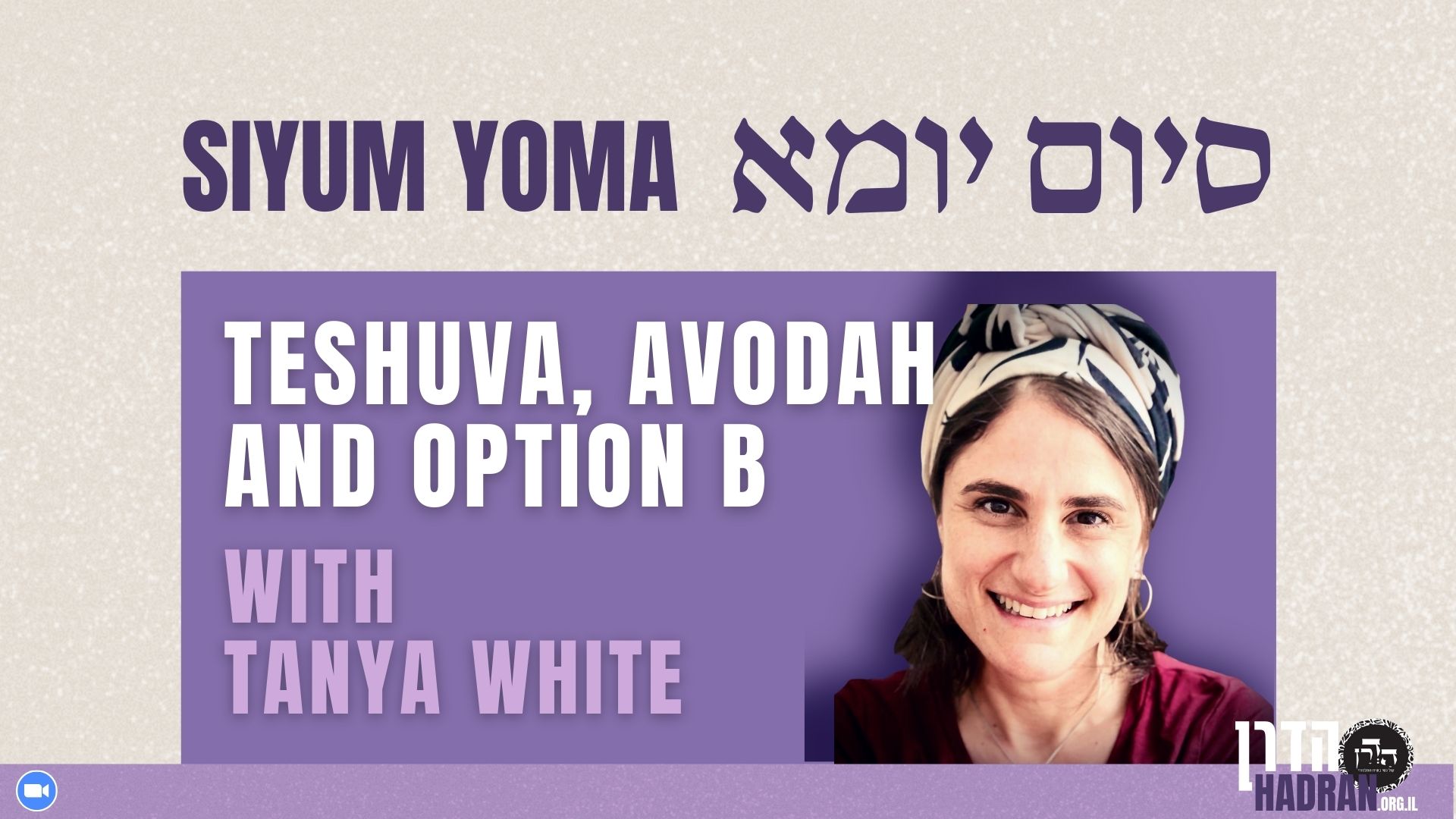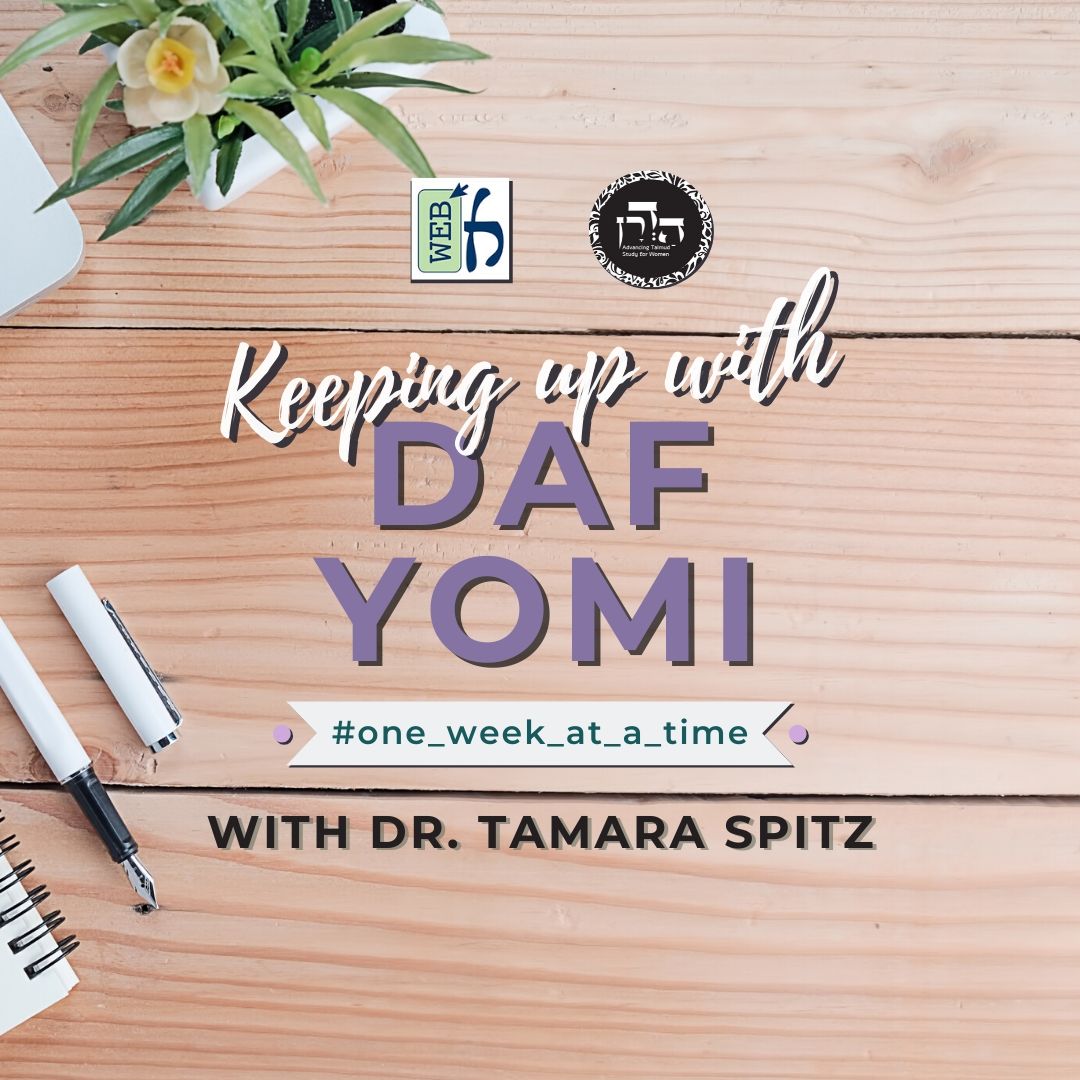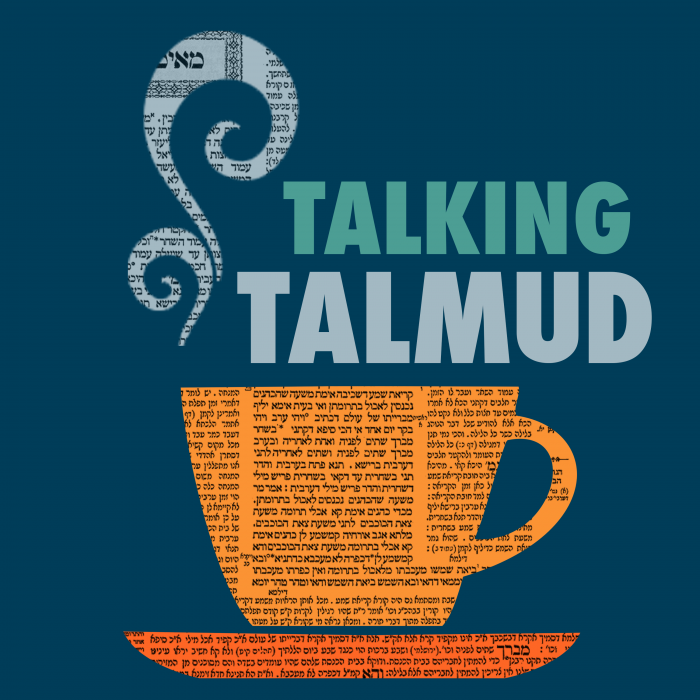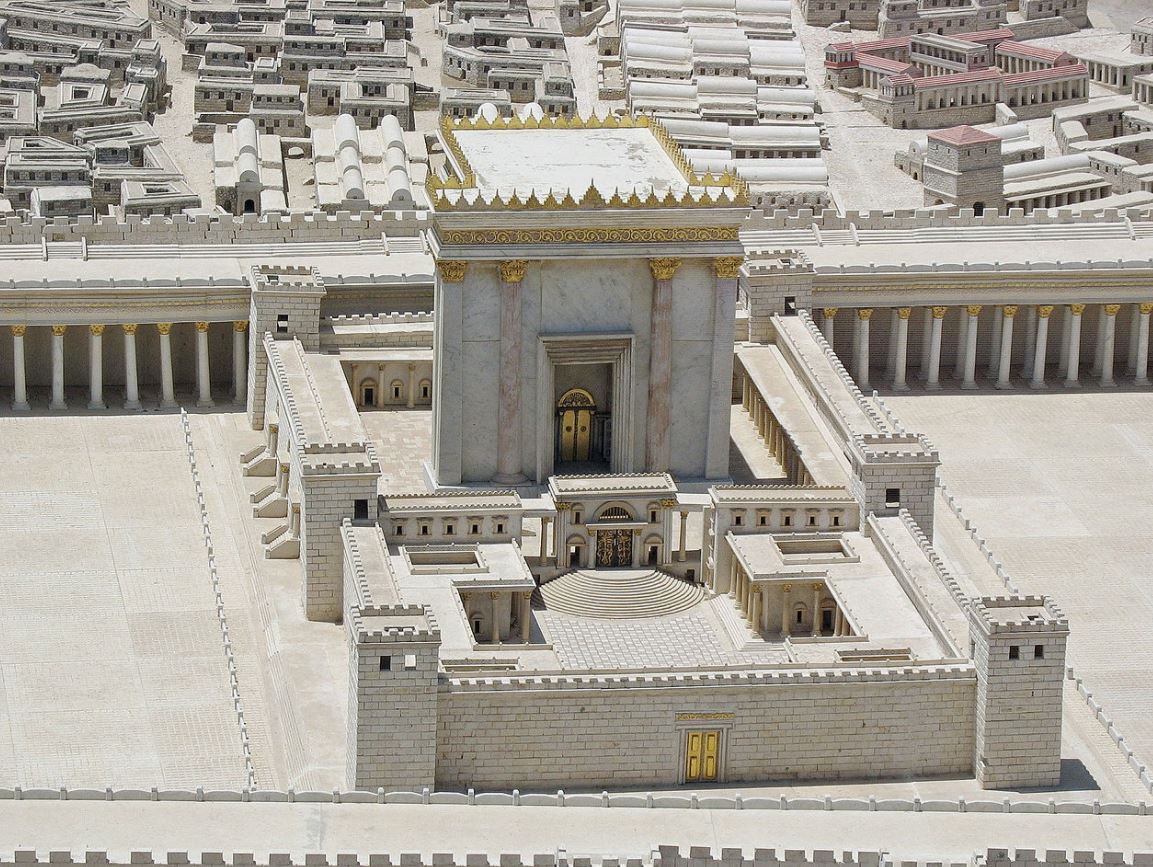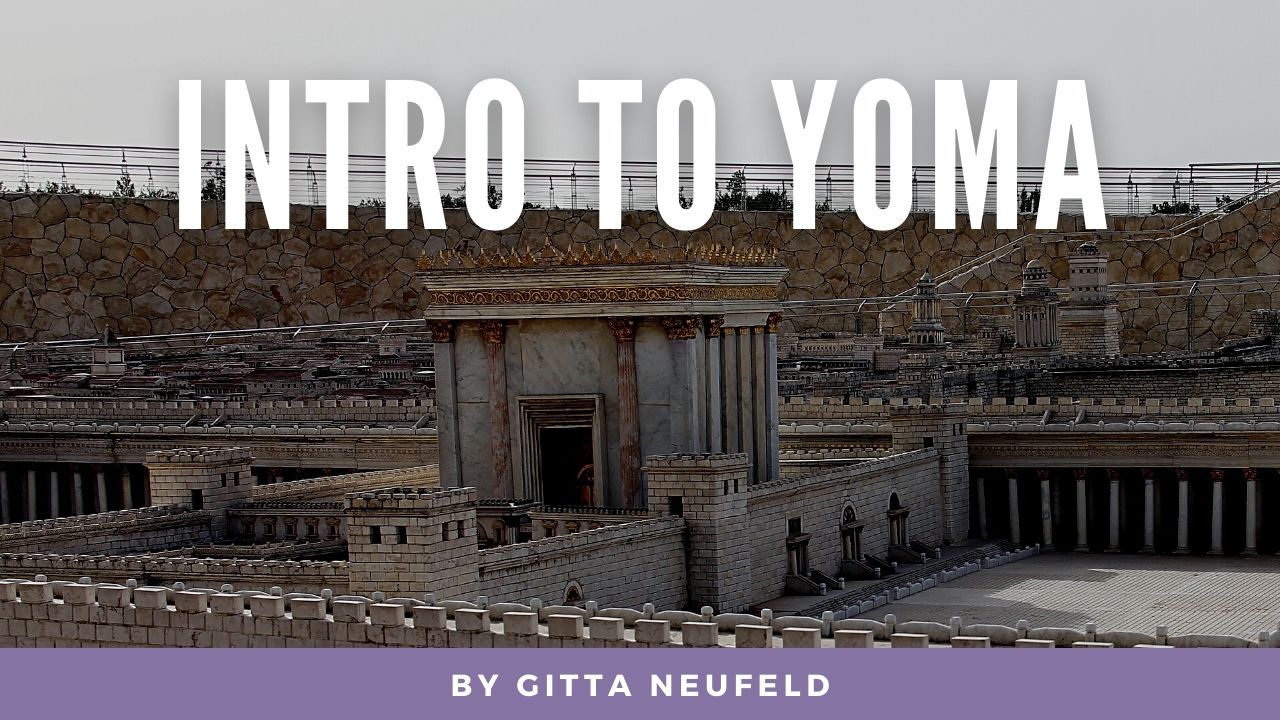Yoma 2
שִׁבְעַת יָמִים קוֹדֶם יוֹם הַכִּפּוּרִים מַפְרִישִׁין כֹּהֵן גָּדוֹל מִבֵּיתוֹ לְלִשְׁכַּת פַּרְהֶדְרִין. וּמַתְקִינִין לוֹ כֹּהֵן אַחֵר תַּחְתָּיו שֶׁמָּא יֶאֱרַע בּוֹ פְּסוּל.
MISHNA: Seven days prior to Yom Kippur the Sages would remove the High Priest, who performs the entire Yom Kippur service, from his house to the Chamber of Parhedrin, a room in the Temple designated specifically for the High Priest during that period. And they would designate another priest in his stead to replace him lest a disqualification due to impurity or another circumstance beyond his control prevent him from entering the Temple on Yom Kippur.
רַבִּי יְהוּדָה אוֹמֵר: אַף אִשָּׁה אַחֶרֶת מַתְקִינִין לוֹ, שֶׁמָּא תָּמוּת אִשְׁתּוֹ, שֶׁנֶּאֱמַר: ״וְכִפֶּר בַּעֲדוֹ וּבְעַד בֵּיתוֹ״, ״בֵּיתוֹ״ — זוֹ אִשְׁתּוֹ. אָמְרוּ לוֹ: אִם כֵּן, אֵין לַדָּבָר סוֹף.
Rabbi Yehuda says: The Sages would even designate another wife for him lest his wife die, as it is stated in the Torah portion of the Yom Kippur service: “And it will atone for him and for his house” (Leviticus 16:6); the Sages interpreted the term: His house, that is his wife. The priest must be married in order to fulfill this commandment. Due to the concern lest his wife die, another wife was designated to address that possibility. The Rabbis said to Rabbi Yehuda: If so, that this is a concern, there is no end to the matter, as what if the designated replacement wife dies? This possibility need not be a source of concern.
גְּמָ׳ תְּנַן הָתָם: שִׁבְעַת יָמִים קוֹדֶם שְׂרֵיפַת הַפָּרָה הָיוּ מַפְרִישִׁין כֹּהֵן הַשּׂוֹרֵף אֶת הַפָּרָה מִבֵּיתוֹ לַלִּשְׁכָּה שֶׁעַל פְּנֵי הַבִּירָה צָפוֹנָה מִזְרָחָה, וְלִשְׁכַּת בֵּית הָאֶבֶן הָיְתָה נִקְרֵאת. וְלָמָּה נִקְרָא שְׁמָהּ לִשְׁכַּת בֵּית הָאֶבֶן — שֶׁכׇּל מַעֲשֶׂיהָ בִּכְלֵי גְלָלִים, בִּכְלֵי אֲבָנִים, וּבִכְלֵי אֲדָמָה.
GEMARA: The halakha of sequestering the High Priest prior to his performance of the Temple service on Yom Kippur is comparable to the sequestering of the priest designated to burn the red heifer. Therefore, the Gemara cites that which we learned in a mishna there, in tractate Para: Seven days prior to the burning of the red heifer, the Sages would remove the priest who burns the heifer from his house to the chamber that was before the bira at the northeast corner of the courtyard on the Temple Mount. And that chamber was called the Chamber of the Stone House. The Gemara explains: And why was it called the Chamber of the Stone House? It is because all the actions associated with the red heifer were performed in dung vessels, stone vessels, and earth vessels, which are vessels that cannot become ritually impure.
מַאי טַעְמָא? כֵּיוָן דִּטְבוּל יוֹם כָּשֵׁר בַּפָּרָה, דִּתְנַן: מְטַמְּאִין הָיוּ הַכֹּהֵן הַשּׂוֹרֵף אֶת הַפָּרָה וּמַטְבִּילִין אוֹתוֹ, לְהוֹצִיא מִלִּבָּן שֶׁל צַדּוּקִין, שֶׁהָיוּ אוֹמְרִים: בִּמְעוֹרְבֵי הַשֶּׁמֶשׁ הָיְתָה נַעֲשֵׂית.
The Gemara asks: What is the reason that they were so stringent with regard to the purity of the heifer? The Gemara explains: It is since a priest who immersed that day is fit for service and may perform the ritual of the heifer after immersion, even before sunset, as we learned in a mishna: They would intentionally render the priest who burns the heifer ritually impure and immerse him immediately, to remove a misconception from the hearts of the Sadducees by means of a public display of disregard for their ruling. As the Sadducees would say: Only by those for whom the sun set was the heifer ritual performed. The Sadducees believed that it is prohibited for priests who began the purification process with immersion during that day to burn the red heifer until sunset, when the purification process is completed.
תַּקִּינוּ לַהּ רַבָּנַן: כְּלֵי גְלָלִים, כְּלֵי אֲבָנִים, וּכְלֵי אֲדָמָה — דְּלָא לִיקַבְּלוּ טוּמְאָה, כִּי הֵיכִי דְּלָא לִיזַלְזְלוּ בַּהּ.
That mishna continues: Since they would intentionally render the priest who burned the heifer ritually impure, the Sages in turn instituted the stringencies of utilizing dung vessels, stone vessels, and earth vessels, which do not have the capacity to become ritually impure, lest people come to treat the ritual with contempt and perform it in ritual impurity after seeing that the red heifer ritual was performed by one who immersed that day.
מַאי שְׁנָא צָפוֹנָה מִזְרָחָה? כֵּיוָן דְּחַטָּאת הִיא, וְחַטָּאת טְעוּנָה צָפוֹנָה. וּכְתִיב בָּהּ: ״אֶל נֹכַח פְּנֵי אֹהֶל מוֹעֵד״ — תַּקִּינוּ לַהּ רַבָּנַן לִשְׁכָּה צָפוֹנָה מִזְרָחָה, כִּי הֵיכִי דְּלֶהֱוֵי לַהּ הֶיכֵּירָא.
Apropos the mishna in tractate Para, the Gemara asks: What is different about the chamber located in the northeast corner of the Temple courtyard that led the Sages to house the priest performing the red heifer ritual specifically in that chamber? The Gemara answers: It is different since it is a sin-offering, as the red heifer is referred to as a sin-offering in the Torah, and the slaughter and sprinkling of the blood of a sin-offering must be performed north of the altar; and since it is written with regard to the red heifer: “And sprinkle it before the opening of the Tent of Meeting” (Numbers 19:4), and before the Tent of Meeting means on its eastern side. Therefore, the Sages established a chamber in the northeast so that the ritual of the red heifer will have a distinctive indicator; this will cause the administering priest to be vigilant in its performance.
מַאי ״בִּירָה״? אָמַר רַבָּה בַּר בַּר חָנָה אָמַר רַבִּי יוֹחָנָן: מָקוֹם הָיָה בְּהַר הַבַּיִת וּ״בִירָה״ שְׁמוֹ. וְרֵישׁ לָקִישׁ אָמַר: כׇּל הַמִּקְדָּשׁ כּוּלּוֹ קָרוּי ״בִּירָה״, שֶׁנֶּאֱמַר: ״הַבִּירָה אֲשֶׁר הֲכִינוֹתִי״.
The Gemara asks with regard to the terminology of the mishna: What is the meaning of the term bira cited there? Rabba bar bar Ḥana said that Rabbi Yoḥanan said: There was a place on the Temple Mount and its name is bira, and the Chamber of the Stone House was adjacent to it. And Reish Lakish said: The entire Temple is called bira, as it is stated in the prayer of David: “To Solomon my son grant a wholesome heart, to observe your commandments, your admonitions, and your statutes, to fulfill them all, and to build the bira for which I have made provision” (I Chronicles 29:19).
מְנָא הָנֵי מִילֵּי? אָמַר רַב מִנְיוֹמֵי בַּר חִלְקִיָּה אָמַר רַבִּי מַחְסֵיָא בַּר אִידִי אָמַר רַבִּי יוֹחָנָן, אָמַר קְרָא: ״כַּאֲשֶׁר עָשָׂה בַּיּוֹם הַזֶּה צִוָּה ה׳ לַעֲשׂוֹת לְכַפֵּר עֲלֵיכֶם״. ״לַעֲשׂוֹת״ — אֵלּוּ מַעֲשֵׂי פָרָה, ״לְכַפֵּר״ — אֵלּוּ מַעֲשֵׂי יוֹם הַכִּפּוּרִים.
§ With regard to the halakhot of sequestering the High Priest prior to performance of the Yom Kippur service, and of sequestering the priest designated to burn the heifer prior to performance of the red heifer ritual, the Gemara asks: From where in the Torah are these matters derived? Rav Minyomi bar Ḥilkiya said that Rabbi Maḥseya bar Idi said that Rabbi Yoḥanan said they are derived from Aaron and his sons, who remained in the Tabernacle for seven days prior to performing the service in the Tabernacle on the eighth day of their inauguration, as the verse states: “As has been done this day, so the Lord has commanded to do, to make atonement for you” (Leviticus 8:34), meaning that this mitzva of sequestering was not limited to the days prior to the dedication of the Tabernacle; rather, it applies to future generations as well. The verse is interpreted homiletically: “To do”; these are the actions performed in the burning of the red heifer for which the priest performing the ritual is sequestered seven days in advance; “to make atonement”; these are the actions performed on Yom Kippur, before which the High Priest is sequestered seven days.
בִּשְׁלָמָא, כּוּלֵּיהּ קְרָא בְּפָרָה לֹא מִתּוֹקַם — ״לְכַפֵּר״ כְּתִיב, וּפָרָה לָאו בַּת כַּפָּרָה הִיא. אֶלָּא, אֵימָא כּוּלֵּיהּ קְרָא בְּיוֹם הַכִּפּוּרִים כְּתִיב!
The Gemara asks: Granted, the entire verse is not established as referring exclusively to the red heifer, as: “To atone,” is written, and the heifer is not capable of facilitating atonement; rather, it facilitates ritual purity. Rather, say that the entire verse is written with regard to Yom Kippur, as the rites performed to achieve atonement on Yom Kippur are similar to those performed during the days of the inauguration. What, then, is the source for sequestering the priest who is to perform the red heifer ritual?
אָמְרִי: יָלֵיף ״צִוָּה״ ״צִוָּה״. כְּתִיב הָכָא: ״צִוָּה ה׳ לַעֲשׂוֹת״, וּכְתִיב הָתָם: ״זֹאת חֻקַּת הַתּוֹרָה אֲשֶׁר צִוָּה ה׳ לֵאמֹר״. מָה לְהַלָּן פָּרָה, אַף כָּאן פָּרָה. וּמָה כָּאן פְּרִישָׁה, אַף לְהַלָּן פְּרִישָׁה.
The Sages say in response: Derive it from a verbal analogy between the terms commanded and commanded. It is stated here, with regard to the days of the inauguration: “The Lord commanded to do,” and it is stated there, with regard to the red heifer: “This is the statute of the Torah that the Lord commanded, saying” (Numbers 19:2). Just as the term commanded there refers to the heifer, so too here, the phrase: “The Lord commanded to do” written in the context of the days of the inauguration refers to the heifer. And just as here, with regard to the inauguration, there is the principle of sequestering prior to performing the service, so too there, in the context of the halakhot of the heifer, sequestering is required prior to performance of the mitzva.
וְאֵימָא, ״צִוָּה״ [״צִוָּה״] דְּיוֹם הַכִּפּוּרִים, דִּכְתִיב: ״וַיַּעַשׂ כַּאֲשֶׁר צִוָּה ה׳ אֶת מֹשֶׁה״? דָּנִין ״צִוָּה״ דְּלִפְנֵי עֲשִׂיָּה מִ״צִּוָּה״ דְּלִפְנֵי עֲשִׂיָּה, וְאֵין דָּנִין ״צִוָּה״ דִּלְאַחַר עֲשִׂיָּה מִ״צִּוָּה״ דְּלִפְנֵי עֲשִׂיָּה.
The Gemara asks: And say that there is indeed a verbal analogy; however, it is not between the red heifer and the inauguration of the priests, but between the term commanded in the context of the inauguration and the term commanded in the context of Yom Kippur, as it is written: “And this will be an everlasting statute for you, to atone for the children of Israel for all their sins once a year; and he did as the Lord commanded Moses” (Leviticus 16:34). In that case, only the sequestering prior to Yom Kippur can be derived. The Gemara rejects this, as a verbal analogy is derived only between functionally similar phrases. One derives commanded that is stated before performance, as in the portion of the heifer, from commanded that is stated before performance in the portion of the inauguration; and one does not derive commanded that is stated after performance in the portion of Yom Kippur from commanded that is stated before performance.
וְאֵימָא ״צִוָּה״ דְּקׇרְבָּנוֹת, דִּכְתִיב: ״בְּיוֹם צַוֹּתוֹ אֶת בְּנֵי יִשְׂרָאֵל״? דָּנִין ״צִוָּה״ מִ״צִּוָּה״ וְאֵין דָּנִין ״צַוֹּתוֹ״ מִ״צִּוָּה״.
Again the Gemara asks: And say that there is a verbal analogy between the term commanded in the context of the inauguration and the term commanded with regard to offerings, as it is written: “On the day that He commanded [tzavoto] the children of Israel to sacrifice their offerings” (Leviticus 7:38). The result would be that any priest sacrificing a communal offering would require sequestering for seven days. The Gemara rejects this: One derives the term commanded from the identical term commanded, and one does not derive the term that he commanded [tzavoto] from the term commanded [tziva].
וּמַאי נָפְקָא מִינַּהּ? וְהָתָנָא דְּבֵי רַבִּי יִשְׁמָעֵאל: ״וְשָׁב הַכֹּהֵן״ ״וּבָא הַכֹּהֵן״, זוֹ הִיא ״שִׁיבָה״, זוֹ הִיא ״בִּיאָה״!
The Gemara raises a difficulty: What is the practical difference between the two terms? Didn’t the school of Rabbi Yishmael teach a verbal analogy with regard to leprosy of houses between the verse: “And the priest shall return [veshav]” (Leviticus 14:39) and the verse: “And the priest shall come [uva]” (Leviticus 14:44)? From that verbal analogy it is derived that this is the halakha with regard to returning, i.e., it is after seven days; and this is the same halakha with regard to coming, i.e., it is also after seven days. Obviously, the less pronounced difference in grammatical forms between tziva and tzavoto should not prevent the teaching of a verbal analogy.
הָנֵי מִילֵּי, הֵיכָא דְּלֵיכָּא דְּדָמֵי לֵיהּ. אֲבָל הֵיכָא דְּאִיכָּא דְּדָמֵי לֵיהּ — מִדְּדָמֵי לֵיהּ יָלְפִינַן.
The Gemara rejects this argument: This applies only where there are no terms that are identical to it; however, where there are terms that are identical to it, we derive the verbal analogy from terms that are identical to it, rather than from terms that are merely similar.
״לְכַפֵּר״ אֵלּוּ מַעֲשֵׂה יוֹם הַכִּפּוּרִים. וְאֵימָא כַּפָּרָה דְּקׇרְבָּנוֹת!
§ The Gemara analyzes the verbal analogy from which the sequestering of the High Priest is derived. The Gemara states with regard to the phrase “to make atonement,” written in the context of the inauguration: These are the actions performed on Yom Kippur. The Gemara suggests: And say that it refers to the atonement of offerings in general, such that any priest engaged in sacrificing atonement offerings must be sequestered seven days beforehand.
מִי יָדְעִינַן הֵי כֹּהֵן מִתְרְמֵי, דְּבָעֵי לֵיהּ פְּרִישָׁה? אָמְרִי, אַלְּמָה לָא?! נִיבְעֵי לֵיהּ פְּרִישָׁה לְכוּלֵּיהּ מִשְׁמֶרֶת בֵּית אָב! דָּנִין דָּבָר שֶׁקָּבוּעַ לוֹ זְמַן מִדָּבָר שֶׁקָּבוּעַ לוֹ זְמַן, לְאַפּוֹקֵי קׇרְבָּנוֹת, דְּכׇל יוֹמָא אִיתַנְהוּ.
The Gemara seeks to reject this suggestion from a practical perspective. Do we know in advance which priest will happen to sacrifice a given offering, and who would consequently require sequestering? The Sages say: Why not? There are certainly ways to do so. Each of the twenty-four priestly watches has set weeks during which it serves in the Temple, and the patrilineal families that constitute that watch have set days during that week on which each serves in the Temple. We could require sequestering for the entire patrilineal family of the priestly watch designated to serve on that day the following week. The Gemara rejects the suggestion that all priests should be sequestered prior to sacrificing an atonement offering. We derive a matter that has a fixed time during the year, Yom Kippur, from a matter that also has a fixed time, the inauguration of the priests for service in the Tabernacle, to the exclusion of offerings that are sacrificed every day.
וְאֵימָא רְגָלִים! דָּנִין דָּבָר שֶׁנּוֹהֵג פַּעַם אַחַת בַּשָּׁנָה מִדָּבָר הַנּוֹהֵג פַּעַם אַחַת בַּשָּׁנָה, לְאַפּוֹקֵי רְגָלִים, דְּלָאו פַּעַם אַחַת בַּשָּׁנָה נִינְהוּ.
Again the Gemara asks: And say that one derives from the phrase “to make atonement” the principle of sequestering prior to sacrificing atonement offerings on the Festivals, which have fixed times. The Gemara rejects this: We derive a matter that is performed once a year, the service of Yom Kippur, from a matter that is performed once a year, like the inauguration, which was a one-time event, to the exclusion of the service on the Festivals, which is not performed once a year; rather, it is performed three times a year.
וְאֵימָא רֶגֶל אֶחָד! וְכִי תֵּימָא: לָא יָדְעִינַן הֵי מִינַּיְיהוּ, אִי חַג הַמַּצּוֹת, הוֹאִיל וּפָתַח בּוֹ הַכָּתוּב תְּחִלָּה, אִי חַג הַסּוּכּוֹת, הוֹאִיל וּמְרוּבָּה מִצְוָתוֹ!
The Gemara asks: And say that the service on one Festival of the three, which is performed once a year, should require sequestering. And if you say: We do not know which of them is the most significant and requires sequestering, since one could suggest that it is Passover, with which the verse opened, as the Torah always lists it first among the Festivals; or one could suggest that it is Sukkot, since its mitzva is to bring numerous offerings, many more than the number brought on the other Festivals.
אֶלָּא: דָּנִין פְּרִישַׁת שִׁבְעָה לְיוֹם אֶחָד, מִפְּרִישַׁת שִׁבְעָה לְיוֹם אֶחָד. וְאֵין דָּנִין פְּרִישַׁת שִׁבְעָה לְשִׁבְעָה, מִפְּרִישַׁת שִׁבְעָה לְיוֹם אֶחָד.
Rather, the Gemara rejects this possibility and explains: One derives sequestering for seven days prior to performing a service for one day, Yom Kippur, from sequestering for seven days prior to performing a service for one day, the inauguration. And one does not derive sequestering for seven days prior to performing a service for seven days, a Festival, from sequestering for seven days prior to performing a service for one day, the inauguration. Therefore, atonement offerings on Festivals are not derived from the inauguration.
וְאֵימָא שְׁמִינִי, דִּפְרִישַׁת שִׁבְעָה לְיוֹם אֶחָד הוּא! דָּנִין דָּבָר שֶׁאֵין קְדוּשָּׁה לְפָנָיו מִדָּבָר שֶׁאֵין קְדוּשָּׁה לְפָנָיו, וְאֵין דָּנִין דָּבָר שֶׁיֵּשׁ קְדוּשָּׁה לְפָנָיו מִדָּבָר שֶׁאֵין קְדוּשָּׁה לְפָנָיו.
The Gemara asks: And say that the sequestering for seven days is prior to the festival of the Eighth Day of Assembly, as that would also be sequestering for seven days prior to performing a service for one day. The Gemara rejects this: One derives a matter before which there is not sanctity, Yom Kippur, which is preceded by weekdays, from a matter before which there is not sanctity, the day of the inauguration, which was also preceded by weekdays. And we do not derive a matter before which there is sanctity, the Eighth Day of Assembly, which is preceded by the seven days of Sukkot, from a matter before which there is not sanctity.
וְלָאו קַל וָחוֹמֶר הוּא? הַשְׁתָּא דָּבָר שֶׁאֵין קְדוּשָּׁה לְפָנָיו בָּעֵי פְּרִישָׁה, דָּבָר שֶׁיֵּשׁ קְדוּשָּׁה לְפָנָיו — לָא כׇּל שֶׁכֵּן! אָמַר רַב מְשַׁרְשְׁיָא: לָא, ״הַזֶּה״ כְּתִיב: כָּזֶה.
The Gemara challenges this: And is it not an a fortiori inference? Now, if a matter before which there is not sanctity requires sequestering, due to its sanctity, then with regard to a matter before which there is sanctity, all the more so is it not clear that it should require sequestering? Rav Mesharshiyya said in rejection of this challenge: No, there is no a fortiori inference here, as the verse: “As has been done this day, so the Lord has commanded to do, to make atonement for you” (Leviticus 8:34), is written to emphasize specifically a day like this day; precisely as it was for the inauguration, and not in any other situation.
רַב אָשֵׁי אָמַר: מִי אִיכָּא מִידֵּי דְּעִיקַּר רֶגֶל לָא בָּעֵי פְּרִישָׁה, טָפֵל דִּידֵיהּ בָּעֵי פְּרִישָׁה? וַאֲפִילּוּ לְמַאן דְּאָמַר שְׁמִינִי רֶגֶל בִּפְנֵי עַצְמוֹ הוּא, הָנֵי מִילֵּי לְעִנְיַן
Rav Ashi said: There is another reason why it could not be that sequestering is required prior to the Eighth Day of Assembly. Is there any matter where the primary Festival, the first day of Sukkot, does not require sequestering, as was already proven, while that which is secondary to it requires sequestering? Since the Eighth Day of Assembly is an addendum to Sukkot, could its sanctity and stringency be greater than that which is associated with the primary Festival? And even according to the one who said: The Eighth Day of Assembly is a Festival in and of itself and is not part of the festival of Sukkot, that applies only to the matter of



